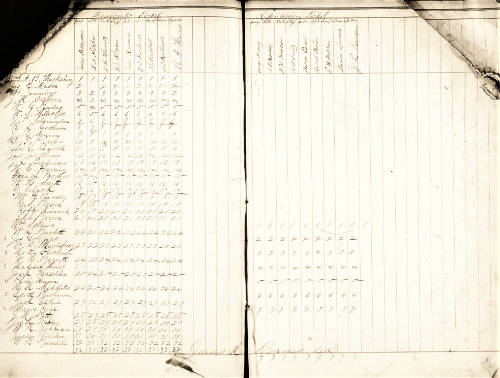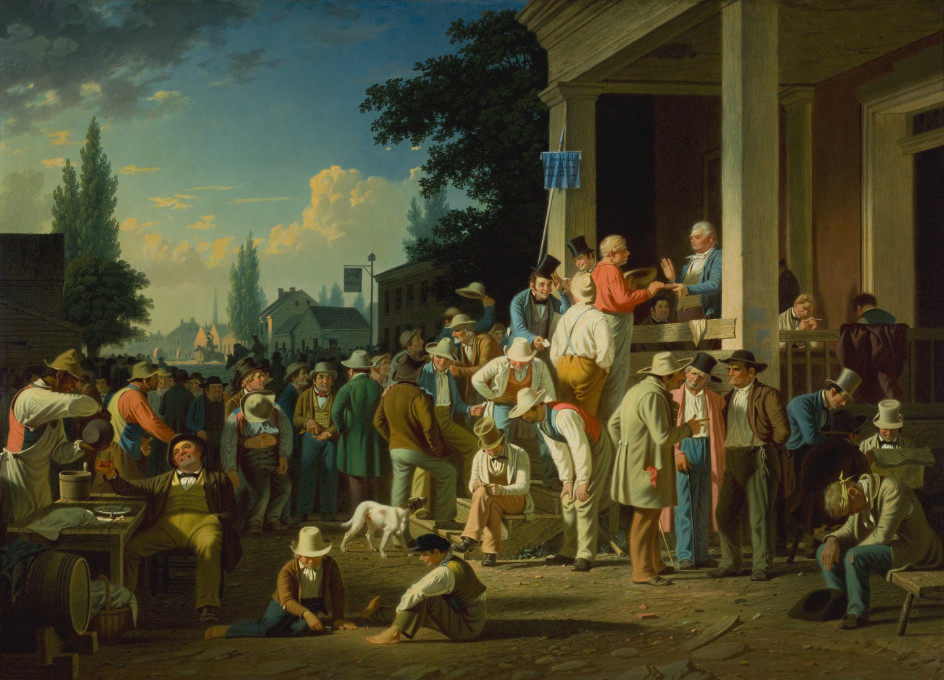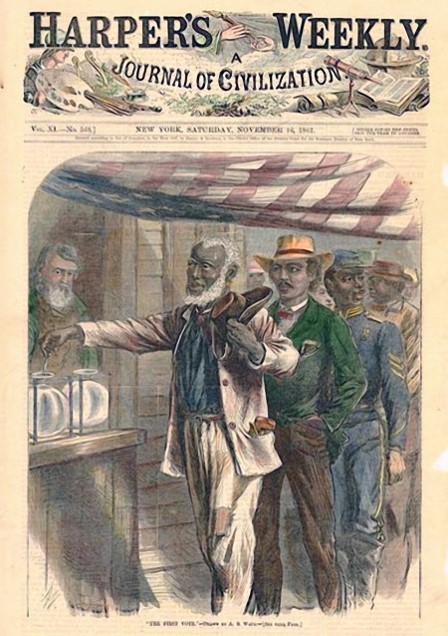
Page of the pollbook for the August 1, 1870, county election in Lancaster precinct in Garrard County. Pollbooks were the official record of an election under viva voce voting, into which the clerk wrote every voter’s name and their electoral choices.
View >

The Australian Secret Ballot used in the 1889 Massachusetts gubernatorial election. The 1889 Massachusetts election was the first state-wide election in which the secret ballot was used (Courtesy of American Antiquarian Society).
View >

“The County Election,” George Caleb Bingham’s famous painting, depicts the 1846 viva voce election for a member of the Missouri state legislature from Saline County (1852. Courtesy of Saint Louis Art Museum).
View >

“The First Vote” cartoon from Harper’s Weekly, showing black men voting in Virginia on October 22, 1867, to elect delegates to the state’s constitutional convention. Note that the men did not vote using a secret ballot but cast party-issued “tickets.”
View >
Kentucky was the last state to abandon viva voce voting when, in 1891, it adopted a new constitution that mandated the Australian secret ballot in all elections.
The new constitution presented a radical revision of the electoral system. All elections — whether state, local, town, or district — were consolidated into a single election day on the first Tuesday after the first Monday in November, falling in place with the national election day. Registration became compulsory in towns with a population above 5,000. And, most importantly, the Australian secret ballot would replace viva voce voting. All future voting would be on state-printed ballots “marked by each voter in private at the polls.”
The Frankfort Roundabout provided the most succinct summary of the changes approved at the August 8, 1891, election:
The last August election was held on Monday, and [was] the last viva voce election. All elections will hereafter be in November and will be by secret ballot.
A Very Different Democracy
While we now accept the secret ballot as a standard and essential part of elections, at the time it was a revolutionary idea.
Before the adoption of the secret ballot, voters either voted by voice (viva voce) or using a non-secret ballot or “ticket.” A ticket was printed by the political parties listing the names of their party’s candidates. Whether voting by voice or by ticket, votes were not secret. Voting took place in public, and each voter’s political choices were knowable by their friends, neighbors, and political parties.
Under the secret ballot, governments list all the legal nominated candidates for office on an official ballot that they, and only they, print out. Voters vote by marking the state-provided official ballot paper in secret. The whole event takes place in silence inside a public building.
This was a very different vision of democracy than the loud, public, outdoor events that characterized viva voce elections.
Implementing the Secret Ballot in Kentucky
Implementing the new system took time and local elections continued to be conducted by voice in Kentucky into early 1893.
Some mourned the passing of an era. In Owensboro, the last local election was held on December 5, 1892 and the Messenger nostalgically noted:
The election [tomorrow] will be held under the old system of viva voce voting, and it will be the last opportunity the voters will ever have of walking up and expressing their votes openly.
Reflecting the opposite view, in December 1889, former Massachusetts Governor Oliver Ames praised the new system in the North American Review. He looked forward to an improved, and reduced, electorate that brought “good manners” to electoral behavior and with the new law requiring the ability to read the state constitution in English, would be “the best test of the ‘reading and writing’ qualification ... that has ever been had.”
The Origins of the Australian Secret Ballot
The Australia secret ballot was developed in the 1850s in the Australian colonies, although Massachusetts came close to creating a similar system in the same decade. The key element of the Australian secret ballot is that the state determines which candidates appear on the ballot (subject to a set of nomination or ballot access rules) and prints and provides the official ballot to voters at polling places on Election Day.
In the ticket voting system, which was used in much of the United States at the time, voting was done by handing in a party’s list of candidates (known as a “ticket”) at the polling place. Tickets could be printed by anyone: political parties, newspapers, splinter parties, aggrieved candidates, or other interested parties. They came in all sorts of shapes, sizes, and colors. Indeed, a scrap of paper onto which an individual scrawled their preferred candidates would often count as a valid vote.
In the 1870s, the Australian secret ballot was adopted in the United Kingdom and by some Canadian provinces. Then, almost twenty years later, the secret ballot found its way to the United States.
Louisville, Kentucky, less than 100 miles northwest of Garrard County, was the first city to use the Australian secret ballot for a local election. Massachusetts was the first state to adopt it, in 1889, for statewide offices.
The Australian secret ballot spread across the country quickly, with only a few holdouts. Just a decade later, at the turn of the century, 38 states had adopted it. Only seven states remained using the ticket system in 1900, with South Carolina completing the switch to the Australian secret ballot in 1950.
Heading 2: Another Tool of Disenfranchisement?
Much of the impetus for the Australian secret ballot was a desire for “reform”—to cleanse the political sphere of corrupt officials and ineligible, or inappropriate, voters. The Australian secret ballot could achieve this by preventing candidates and parties from being able to tell if someone actually voted for them or not. Bribery and coercion became almost impossible, because there was no way to know how the voter voted. Plying those who claimed to have voted for you with gifts of meat or alcohol was no longer a rewarding campaign strategy, so election day crowds and revelry receded, and elections became more somber affairs.
State legislatures’ motives for the adopting the new system varied, but in the South the secret ballot was rich in disenfranchising possibilities and temptations. Literacy tests were an obvious effort to eliminate black and poor voters, but so too was a written, printed Australian secret ballot, that had to be read. Literacy was a key component of the Australian secret ballot. Unsurprisingly, turnout plummeted after its adoption across the country, as was often intended.
Reflecting an awareness of the effect of the Australian secret ballot, the Arkansas Democratic Party’s 1892 campaign song was called “The Australian Ballot.” Sung to the tune of the “Bonnie Blue Flag,” the national anthem of the former Confederacy. It goes:
The Australian ballot works a charm,
It makes them think and scratch,
And when a negro gets a ballot,
He certainly has got his match….
They go into the booth alone
Their ticket to prepare.
And as soon as the five minutes are out
They got to get from there.







